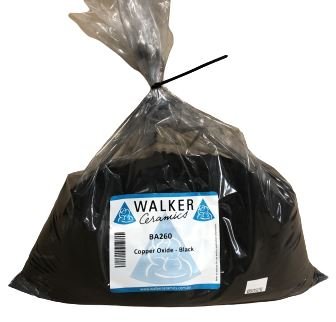- HOME
- >
- RAW MATERIALS
- >
- OXIDES
- >
- Copper Oxide - Black
Copper Oxide - Black
Copper Oxide—Black
Copper Oxide is one of the oldest colorants used by potters and is the most stable form of oxidized copper. It is a popular source of copper in glazes and glass. It is a very strong flux (A ceramic flux functions by promoting glass formation in clay bodies and glazes.) The oxide form of copper can give a speckled colour in glazes whereas the carbonate form will give a more uniform effect. Copper normally produces green colours in amounts to 5% where it moves toward black. In reduction firing, it turns to Cu2O and gives vibrant red hues. It the glaze is fluid copper will tend to crystallize heavily.
Above 1025°C, copper becomes increasingly volatile and its crystalline structure breaks down. At 1325°C, copper melts. This can affect the colour of other glazes pieces in the kiln.
Copper gives green in most fritted glazes, the colour being darker and richer in lead bearing glazes. In alkaline type glazes, the colour tends to blue, as is also the case in emulsion opacified high boron glazes, sometimes called boron blues. Large amounts of copper in glazes, especially lead glazes, give metallic effects and even graphite-type matts. Copper is an active flux and it may increase glaze melt fluidity; it may also cause crazing, due to its thermal expansion. In certain glaze compositions, under controlled reducing conditions, copper compounds can produce the reduced reds of rouge flamb and sang-de-boeuf; however these are difficult to obtain reliably. Since beautiful reds can now be reliably made with cadmium-selenium glazes, there is no longer any necessity to produce the reduced copper reds.
